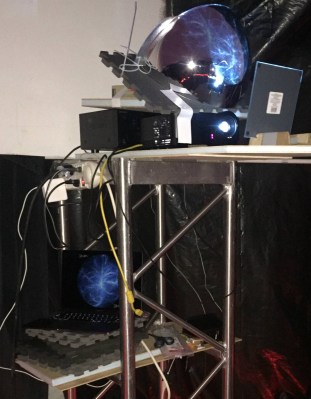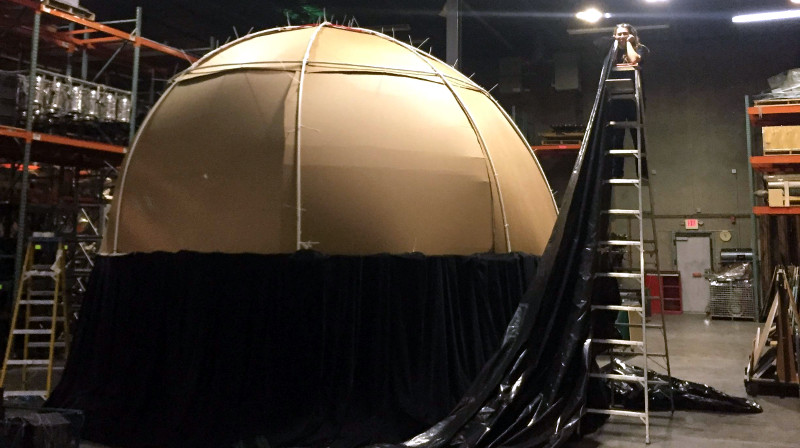When you think about DIY projects, you probably don’t consider building your own planetarium. Why would you? Building the thing is surely outside the capabilities of the individual, and even if you could figure it out, the materials would be far too expensive. There’s a limit to DIY projects, and obviously building a planetarium is on the wrong side of the line. Right?
 Well, apparently not. [Gabby LeBeau] has documented the planetarium she built as her senior project, and if you’ll forgive the pun, it’s absolutely out of this world. Using readily available parts and the help of family and friends, she built a fully functional planetarium big enough to seat the Physics Department. No word on what grade she got, but it’s a safe bet she screwed the curve up for the rest of the class.
Well, apparently not. [Gabby LeBeau] has documented the planetarium she built as her senior project, and if you’ll forgive the pun, it’s absolutely out of this world. Using readily available parts and the help of family and friends, she built a fully functional planetarium big enough to seat the Physics Department. No word on what grade she got, but it’s a safe bet she screwed the curve up for the rest of the class.
After two months of research and a couple of smaller proof of concept builds, she was able to find a business who graciously allowed her to construct the full scale planetarium in their warehouse. The frame is made of PVC pipes held together with zip ties. The big advantage to using the PVC pipes (beyond being cheap and easy to works with) is that they will automatically find a hemispherical shape when bent; saving the time and trouble it would take to create the shape with more rigid building materials.
 Once the PVC frame was up, white cardboard panels were cut to shape and attached to the inside. The panels were lined up as closely as possible, but gaps were covered with white tape so the fit didn’t need to be perfect. When the dome was finished, it was lifted and placed on metal trusses to get some room underneath, and finally covered with a black tarp and stage curtain to block out all light.
Once the PVC frame was up, white cardboard panels were cut to shape and attached to the inside. The panels were lined up as closely as possible, but gaps were covered with white tape so the fit didn’t need to be perfect. When the dome was finished, it was lifted and placed on metal trusses to get some room underneath, and finally covered with a black tarp and stage curtain to block out all light.
Of course, she didn’t go through all this trouble to just stick some glow in the dark stars on the inside of this thing. The image from a standard projector is directed at a flat mirror, which then bounces off of a convex mirror. Driving the projector is a laptop running Stellarium. While there were some imperfections she couldn’t get polished or cleaned off of the mirrors, the end result was still very impressive.
Unfortunately, you can’t really do a planetarium justice with a camera, so we aren’t able to see what the final image looked like. But judging by the slack-jawed faces of those who are pictured inside of it, we’re going to go out on a limb and say it was awesome.
We might suggest trying to quiet down the projector or adding some lasers to the mix, but overall this is a truly exceptional project, and we’re jealous of everyone who got to experience it first hand.
















“When you think about DIY projects, you probably don’t consider building your own planetarium. Why would you? Building the thing is surely outside the capabilities of the individual, and even if you could figure it out, the materials would be far too expensive. ”
I was thinking more the space it would take up. Hopefully being PVC it was as easy to disassemble.
“outside the capabilities of the individual”
Mmm… not really.
“Eisinga’s vast knowledge of mathematics and astronomy came in handy when, in May 1774, turmoil broke out in response to Eelco Alta’s prediction. In order to give the people a correct picture of the solar system, he built a model of the solar system in his living room. Only seven years passed between his very first idea and the final realisation of this project. Since 1781, Eisinga’s model has closely followed the paths of the 6 planets in our solar system. This makes it the oldest still-functioning planetarium in the world. ”
http://www.planetarium-friesland.nl/wp-content/uploads/2017/09/260517teamhorsthuis_DSC9659.jpg
That’s totally cool and well done, actually it’s Badass! Congratulations indeed.
Check this out: http://www.cccoe.net/stars Shows another another method for construction.
The hard part of a pletarium build would be the projector. If you’re just building a hemispherical projection screen, why would that be hard?
If you visit a real planetarium, the projector is critical to the experience. Using a regular projector is neat, and I’m sure this is a lot of fun for kids, and so is a great project. To the kids it will seem a lot like a real planetarium, because they’re not actually expected to learn anything; the goal is to excite and inspire them.
But it doesn’t seem to have any interesting build qualities related to planetariums.
What are you talking about? They built a projector as well.
Well I certainly hope students visiting this or any other planetarium will learn things. You can, for example, simulate the actual observations of Venus and collect data to plot its orbit; the same is true for Mars but it’s a bit more challenging. You can show the effects of latitude on the angle of the celestial equator and show the connection to the observer’s latitude on the altitude of the North Star. With the rig describe here you could show inferior and superior planet motions, retrograde loops, moon phases, and navigate between stars using Celestia as well as Stellarium. Then there are the free content projection fulsome shows from the European Space Agency among others. It’s as real a planetarium as you want to make it.
This is perfect for my project! I cannot see how the top of the dome has been assembled. Are the pipes cut and joined at the top? If so, how?
I built many in many different ways. My studio has 2 12’x12′ x12′ projection/camera rooms. Best easy results were paper mache on big beach balls. DIY a pressure regulator. Best 3D effect is achieved projecting on the outside of a sphere. Bigger WOW factor than a small planetarium. Best of best is dual projector 3d so the stars are both in and outside the sphere. Best of all, 2D movies go 3D ( even better after 3D cyber 2D to 3D conversion)
Also big curved screen is cool – “Saving Private Ryan” beachead sean was hard to watch – especially with stereo boom box blasting at the screen from the posution of the projector – voice seem to come from the mouths of the actors etc.